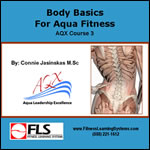
By: Connie Jasinskas, M. Sc.
Body Basics for Aqua Fitness is designed to give you fundamental knowledge about functional anatomy, kinesiology, and physiology related to vertical aquatic training (aqua fitness). This course (AQX Course 3) explains muscle roles and priorities, key training principles, as well as physiology of vertical immersion. Over 71 videos and several interactive and printable activities. Whether you are working with sports teams, post-rehabilitation groups, aquatic personal training, or seniors' group aqua fitness, Body Basics for Aqua Fitness is fundamental to your success.
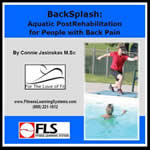
By: Connie Jasinskas MS
Over 80% of the U.S. population suffers from low back pain at some time in their life, some with chronic low back pain issues. Most low back pain is attributed to muscle imbalance and is relieved and prevented by a properly executed exercise program conducted by a knowledgeable professional. This course shows how vertical aquatic exercise can be used in post-rehabilitation for back pain by aquatic rehabilitation practitioners, as well as aquatic leaders providing individual or group exercise for this population. Videos and pictures give you a clear understanding of the exercises and progressions shown in the course. If you want to get exceptional results with your back pain clients, this course is a must!
Other Online Courses Available

By: June M. Chewning, M.A.
It's such a satisfying experience to finish your workout knowing you have created a calorie deficit. Many clients are trying to manage their weight and want to know "How many calories did I burn in this workout?" In order to answer this commonly asked question, it is important to understand the many factors that affect caloric consumption. This quick study will help you guide your clients to better exercise choices and help you better understand the "skinny" on measuring energy production and intensity and the variables that affect caloric consumption.
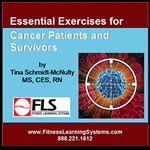
By: Tina Schmidt-McNulty MS CES RN
Cancer is the second leading cause of death in the United States. It is a very serious diagnosis with a multifaceted approach starting from identification all the way through treatment. Cancer patients are now encouraged to exercise during and after treatment. This course includes important information for health-fitness professionals about cancer and exercise guidelines. Videos guide you through a simple exercise progression for clients with cancer or who are cancer survivors. In the search for a cure, physical activity proves a valuable tool in prevention, treatment, and a progressive return to daily living activities. Learn how to embrace this client base and provide safe and effective programming options.
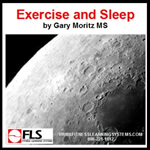
By: Gary Moritz MS
Sleep is a fundamental and important human need, but few people know how important it really is. Some people even try to get by with as little sleep as possible. Even so, everyone needs sleep. As a health-fitness professional, you know about the many benefits of regular exercise. You could recite them in your sleep. But did you know that even a single bout of exercise can help improve the quality of sleep? And with that improved sleep comes many additional health benefits. So get ready to add to your list of exercise benefits as we discuss healthy sleep, sleep disorders, and what research has discovered about the effects of exercise upon sleep quality.

By: Mary Essert BA ATRIC and Vickie Ramsey RN CPC
As a health-fitness professional, you may encounter clients with Post Polio Syndrome. Exercise is important, but can easily cause or accelerate serious problems. It is imperative to understand how to effectively and safely work with these clients without causing harm to occur or symptoms to re-occur. Although this course focuses on water exercise, the information is valuable to land exercise as well. Techniques to increase range of motion, strength, endurance and relaxation are clearly shown. Videos and text emphasize independence and functional fitness as the goal. Learn important guidelines for how to work with clients with Post Polio Syndrome and learn how to help them "Conserve to Preserve" to improve and maintain quality of life.
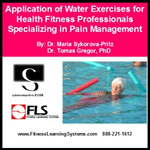
By: Dr. Maria Sykorova-Pritz and Dr. Tomas Gregor PhD
The number of people suffering from chronic pain conditions is growing indicating a need for effective chronic pain management programs. Chronic pain associated health care costs is estimated to be $80 billion each year in the USA alone. People suffering from chronic pain need to be fully educated about the process of managing pain. Knowledge is power for the chronic pain sufferer. With the information and techniques presented in this course, you as a health-fitness professional can increase your client's ability to manage chronic pain.

By: Sandy Stoub MS
Learn how to apply and incorporate Activities of Daily Living (ADLs) into training formats for all ages. The application of multiple strategies, drills, and methods of training allow individuals of all ages to become functionally prepared for life. Multi-plane and multi-sensory methods will be addressed through a science-based, practical approach to understanding an integrated body concept. There are sample programs, sample combinations, and video to guide you through the concepts. Freshen your training and group fitness sessions by adding some practical functional elements.
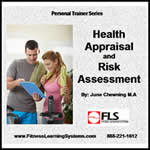
By: June Chewning MA
Health Appraisal and Risk Assessment set the stage for legal responsibility to your client and enable you to limit liability exposure as a health-fitness professional. Understanding this process and using it correctly aligned with industry standards will help you properly screen your client for potential risk. This course teaches you how to navigate through the process dictated by the American College of Sports Medicine Guidelines. It includes several printable assessment forms and covers many important topics that all health-fitness instructors must understand to practice within industry standards.
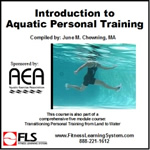
By: June M. Chewning MA
If you are a personal trainer interested in expanding your training options to the water, it is important to learn about the aquatic environment. The water's viscosity provides resistance that surrounds you and provides "work" for every movement in every direction. The water's buoyancy reduces body mass, impact to weight bearing joints, and spinal decompression in deep water. The water's hydrostatic pressure affects many of the body's physiological functions. If you want to be an effective aquatic personal trainer, learn about the special benefits and qualities the aquatic environment has to offer and incorporate that knowledge into your personal training sessions. This course will start you on your way to becoming a successful aquatic personal trainer.
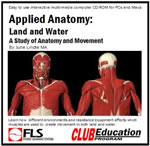
By: June M. Chewning MA
Applied anatomical movement can be confusing for any health-fitness professional. This easy to use multimedia course advances your knowledge of basic human movement, muscle use, types of contractions, and the muscle equation for both land and water environments. Deepen your understanding of concentric/eccentric action as it pertains to specific movements and equipment use on land and in water. Gain confidence in understanding the purpose of every exercise you prescribe so you can provide safe and effective programming for your group fitness and one-on-one clients.

By: Dr. Emily Splichal DPM MS MPH NASM-CES NASM-PES NSCA-CPT
Almost 80% of American adults will suffer low back pain at some point. Interestingly, 70-80% of low back pain is associated with musculoskeletal imbalances and improper core activation during everyday movement. Join us as we take a look at the latest research on the biomechanics of low back pain. From the hip to the foot, you will be surprised by how many different imbalances attribute to low back pain. Help your clients get their bodies back in balance and move pain free!

By: Jack Wasserman PhD, June Chewning MA, Gary Moritz MS
Increase your understanding and professionalism by expanding your knowledge in human movement. This course contains text, photos, interactive graphics, and video to help you deepen your knowledge for the fundamentals of human movement and the unique way each person moves. Make each exercise work for your clients. Develop your ability to effectively understand and modify exercises in order to personalize an exercise movement or routine.
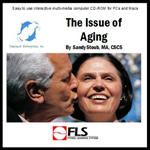
By: Sandy Stoub MA CSCS
This course provides an important overview of aging through physiological, psychological, and sociological perspectives. With a thorough understanding of the aging body, a health-fitness professional can design effective programs to meet the needs of students. Videos and exercise descriptions are included for chair and standing exercises as well as exercises for in the water. Meet the demands of this growing population with safe and effective exercise options.
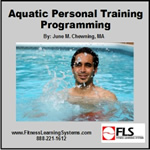
By: June M. Chewning MA
If you are a personal trainer interested in expanding your training options to the water, it is important to learn about the aquatic environment. Increase your success by understanding the properties of the water and aquatic physiological responses. This course teaches you training formats that work well in the aquatic environment as well as shallow and deep water exercise techniques. It also addresses the proper way to monitor and manipulate intensity in the aquatic environment, a skill critical to the success of your client reaching his/her goals.
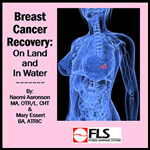
By: Naomi Aaronson MA OTR/L CHT and Mary Essert BA ATRIC
There are over 2 million breast cancer survivors in the United States today. Due to the ramifications of treatment, exercise is a modality that can be used to facilitate recovery. Numerous studies have demonstrated that exercise can improve quality of life, reduce side effects of treatment, and improve strength and endurance. This course will help health-fitness professionals understand diagnosis, treatment, and ongoing care for cancer patients and survivors. Important guidelines and information are provided for safe and effective exercise through course and multimedia content. Embrace this client base with practical exercise options to improve recovery and function.
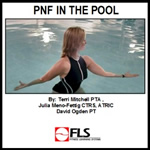
By: Terri Mitchell PTA, Julia Meno-Fettig CTRS ATRIC, David Ogden PT
PNF is characterized by mass movement patterns that are spiral and diagonal. You use PNF patterns of movement and components of them in most of your functional daily activity. This course offers basic educational information regarding proprioceptive neuromuscular facilitation techniques appropriate for performance in the aquatic environment to use with all levels of clients. See text, photos and video demonstrations as the authors teach PNF movements for use in therapy and fitness environments, one-on-one or in group fitness applications. PNF training helps your clients maintain important functional movement patterns.
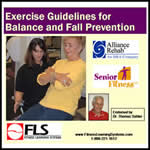
By: Alliance Rehab
Two major problems we all experience as we age are a loss of depth perception and contrast sensitivity creating the underlying cause of poor balance and falling. Decreased muscular efficiency and inadequate control of environmental factors contribute to these conditions. This course provides a comprehensive overview of balance and fall prevention, risk factors for falls, the restrictions and limitations of working with this population, and specific recommendations regarding exercise protocols.
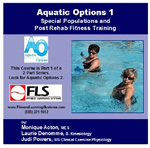
By: Monique Acton MES, Laurie Denomme B Kinesiology,
Judi Powers MS Clinical Exercise Physiology
This course is the first module of a two-part series. Aquatic Options was specifically designed for aquatic fitness professionals, Personal Trainers, Physical Therapy Assistants, Occupational Therapy Assistants, Recreational Therapists, and any professional working with special populations and post rehab individuals in the aquatic environment. This course will review important fitness training guidelines and help you better understand how to integrate progressive aquatic fitness exercises for shoulder, knee and hip orthopedic considerations and low back pain.
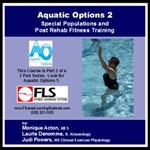
By: Monique Acton MES, Laurie Denomme B Kinesiology,
Judi Powers MS Clinical Exercise Physiology
This course is the second module in the Aquatic Options series. Aquatic Options was specifically designed for aquatic fitness professionals, Personal Trainers, Physical Therapy Assistants, Occupational Therapy Assistants, Recreational Therapists, and any professional working with special populations and post rehab individuals in the aquatic environment. In this course you will learn simple modifications for participants with specific medical conditions including arthritis, diabetes, hypertension, and obesity. This module provides an introduction to the assessment, evaluation, documentation and reporting process. In addition, you will gain the confidence to choose appropriate equipment for all of the populations discussed in both courses. Put together all that you have learned in both courses using the sample programs provided and be able to design your own safe and effective aquatic fitness programming.

By: Sandy Stoub MS CSCS
Running out of choreography ideas? Sandy Stoub combines her gerontology knowledge with her rich teaching experience to bring you a complete basic program for older adults. You can use this information to start an older adult class or introduce new ideas to your existing class or personal training. Exercises are performed seated in a chair and standing next to a chair. The choreography for this course is taken from the complete continuing education course called " The Issue of Aging." Please see this course for additional information on programming guidelines for older adults.

By: Sandy Stoub MS CSCS
Running out of choreography ideas? Sandy Stoub combines her gerontology knowledge with her rich teaching experience to bring you a complete basic program for older adults. You can use this information to start an older adult class or introduce new ideas to your existing class or personal training. Exercises are provided for a "Gentle" water workout and an "Active" water workout.
The choreography for this course is taken from the complete continuing education course called " The Issue of Aging." Please see this course for additional information on programming guidelines for older adults.
Not approved by your
certifying organization?
Our courses are very affordable
even when you use our easy
petition process.
Click Here for Additional Information about
Continuing Education Approval
- AOTA: "The assignment of AOTA CEU's does not imply endorsement of
specific course content, products, or clinical procedures by AOTA"
- ACSM: American College of Sports Medicine's Professional Education
Committee certifies that Fitness Learning Systems meets the criteria for
official ACSM Approved Provider status from (2008 – 2011). Providership
# 652725. ACSM approved providership of this program does not imply
endorsement of the sponsoring organization's products/services.
| 
